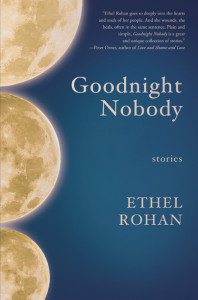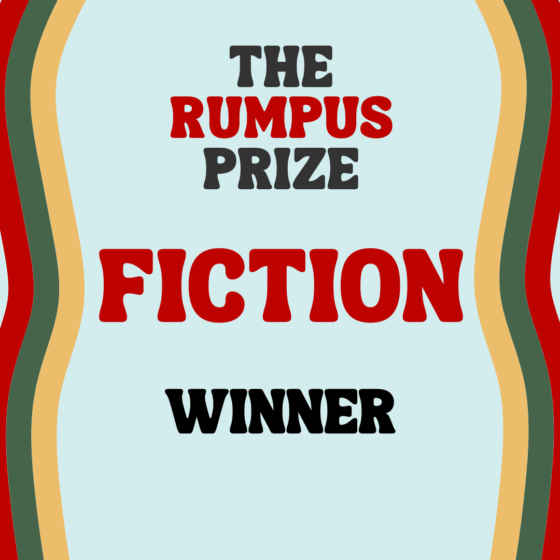 Ethel Rohan’s stories are snapshots. Stark vignettes. We see her characters in the middle of conflict, just at the moment of their potential undoing. In Rohan’s collection, Goodnight Nobody, she assembles thirty short stories that show each character walking a line. Rohan understands light and shade, the hard edges between things, and her short tales manage to capture this in small moments. Goodnight Nobody demonstrates attentiveness to each character’s sense of identity and how they come up against the world.
Ethel Rohan’s stories are snapshots. Stark vignettes. We see her characters in the middle of conflict, just at the moment of their potential undoing. In Rohan’s collection, Goodnight Nobody, she assembles thirty short stories that show each character walking a line. Rohan understands light and shade, the hard edges between things, and her short tales manage to capture this in small moments. Goodnight Nobody demonstrates attentiveness to each character’s sense of identity and how they come up against the world.
Rohan’s characters show people in various stages of grief, turmoil and decision-making. The resulting effect is an overall feeling of tension in the collection; each individual tale presents a stark portrait of a man or woman in flux. There’s the hobbyist stained-glass maker, struggling with her abandoned dreams and a lawsuit; a daughter, cleaning a wine stain, remembering her mother’s aneurism; a photographer, climbing into a giraffe enclosure at a zoo to get one last great picture before she goes blind. Rohan’s characters are of mixed background and temperament and though they seem to be wounded, they possess a deep, abiding pride—both of family and of place.
In “Flash,” the stained glass-maker assembles glass, bleeding onto her work because of the toxic fumes. She considers her creation—and intent—giving us commentary on the artistic process:
“She feels ambitious about this window, a first for her, and wants the large piece to dazzle and draw people like a mirror. She’s playing around with light and dark and crooked and jagged, wanting the window to finish misshapen and almost frightening, gorgeous on the edge of grotesque. She cleans the glass and the copper foil and then fires up the solder iron. Lined on the shelves and scattered about the floor are her finished pieces; bowls, soap trays, photo frames, and ornaments to hang in windows to catch the light.”
This is what Rohan does, too—solder together images that will catch the light. Though each tale is short and we get only a glimpse of each character—often at his or her moment of greatest tension, Rohan highlights so much in each story. Many of Rohan’s characters are “gorgeous on the edge of grotesque,” as—she reminds us—we all are. Rohan sees the strange beauty in people and reflects it in her art.
Grief factors into several of the tales, particularly grief that has to exist side by side with more banal elements of daily life. Whether in the tale of a conflicted reserve soldier, or in a daughter’s inability to understand her parents’ volatile relationship, Rohan’s characters often deal in extremes that coexist both internally and externally. In “Keepsake,”
“Brigid’s stomach clenche[s] at the thought of drinking red wine, of taking its syrup into her. All those years ago, her mother’s death had started with a nosebleed inside the bathroom. Later that night, her father had tried to hold all six children to his chest, had told them a lump in their mother’s brain had burst and she was gone.”
Blood and wine, inextricably linked, are blended here in a pedestrian context. But Rohan’s Brigid tries to process her mother’s death by taking this blood—and the wine—literally into herself. Brigid, like many of Rohan’s characters, is marked by grief while also living in a world marred—and marked—by pain.
“Darkroom” is a tale about a photographer going blind; she wants to photograph a giraffe before her sight is gone.
“She talked about her dream from the previous night, how she had climbed inside the tallest giraffe’s neck and taken photographs from inside its mouth, way up high. She had won prestigious prizes for the photographs, and they were published in a big glossy book.
‘But by the time it came out,’ she finished, laughing, ‘I was already blind, so I ate it.’”
The cruelty of the coming loss isn’t lost on her, and she says, “It’s like every passing second, my eyes are emptying.” Like many of Rohan’s characters, imminent change and the fear of loss makes her bold—it causes her to make choices she wouldn’t otherwise. At the zoo, desperate to get as close to her art as she can, she climbs into the giraffe’s enclosure. Rohan’s characters are most interesting when they’re impulsive. These are people testing their own limits, often paying a price.
Rohan is a writer who knows how to capture big things in a small space. She writes with economy of words and vivid contrast. Goodnight Nobody is sometimes sad, sometimes funny, and always sharply focused.




